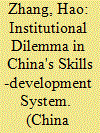| Srl | Item |
| 1 |
ID:
176589


|
|
|
|
|
| Summary/Abstract |
Policymakers in developing countries have prioritized the mass expansion of vocational education and training (VET). This study examines whether the quality of VET in developing countries increases by investing greater resources per student. To achieve this goal, we examine the impacts of attending model schools (which have far more resources per student) on a range of student cognitive, non‐cognitive, and behavioral outcomes. Using representative data from a survey of approximately 12,000 VET students from China, multivariate regression and propensity score matching analyses show that attending model vocational high schools do not benefit student outcomes, despite their substantially greater resources.
|
|
|
|
|
|
|
|
|
|
|
|
|
|
|
|
| 2 |
ID:
183238


|
|
|
|
|
| Summary/Abstract |
The Chinese government has placed workforce upskilling at the core of its reform agenda to sustain the Chinese “economic miracle.” As such, the Ministry of Human Resources and Social Security (MOHRSS) and Ministry of Education (MOE) have each launched separate apprenticeship reforms geared towards enhancing China's oft-criticized vocational education and training system. Using a self-constructed theoretical framework, this article examines the two reforms and ascribes their divergent outcomes to the two ministries’ distinct approaches to institutionalizing their central initiatives (i.e. the top-down model followed by the MOHRSS versus the collaborative model of the MOE). However, given the absence of industry-level civil society governance in China, neither of these models has delivered ideal training outcomes, although the collaborative model has satisfied more employers and apprentices. China's skills-development reforms have thus become trapped in an institutional dilemma which is likely to impede the long-term economic restructuring efforts of the central state.
|
|
|
|
|
|
|
|
|
|
|
|
|
|
|
|